

Armor is essentially hard clothing. It is made of cloth or leather or metal or a combination of the three, and it is worn by people who want something hard between themselves and sharp edges wielded by antagonistic attackers.
Armor is generally heavier than normal clothing, and is hot and uncomfortable to wear. However, warriors wear armor to keep them alive by absorbing damage, not to loll about in it. If possible, armor is worn over the entire body. Sometimes this is not possible because the wearers do not have the strength for it. Sometimes they need freedom of limbs to use a missile weapon. And sometimes they simply cannot stay in a suit of stuffy armor in the middle of summer. Sometimes, too, a suit of armor is too costly, and warriors can scrape together only what they need to cover their vital organs, and must leave their limbs unprotected.
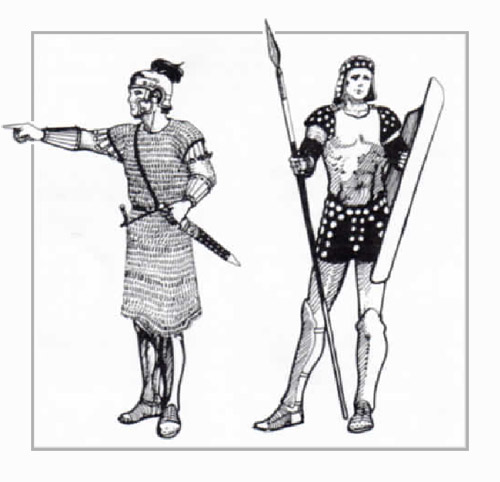
A Comparison of Armor Types
(left) lamellar vambraces, ring armor hauberk, plate greaves
(right) bezainted helm and skirt, cuir bouilli cuirass and greaves; spear and hoplite shield
Soft leather is a rough equivalent of a leather jacket or vest. It is common among ordinary folk. Soft leather is often worn under armor as additional padding or protection. Cloth padding (P) used underneath armor is equivalent in protective quality to soft leather. (Protection 1)
Hard leather is equal to approximately 5mm of leather. It is used by those who cannot afford, or have not been provided by their Cult with, more protective armor. It has the consistency of the leather used in modern shoe soles. Most uncut hides approximate the protective quality of hard leather. (Protection 2)
When boiled in water or wax, this leather can be molded into any desired shape and left to harden. After that, it cannot be reshaped without breaking. The long and tedious process of cuir bouilli making makes it similarly priced to some metal armor. (Protection 3)
This is soft leather armor with metal disks that resemble the bezant, a medieval coin, fastened on. This is generally made more quickly than cuir bouilli, although it commands a greater price due to the extra cost of the metal. (Protection 4)
Like bezainted armor, this is soft leather or some other backing with metal sewn to it. This metal is in the form of rings like those found in chainmail. The rings tend to be closer together than those on bezainted armor, making for both more weight and better protection. Ringmail takes more work than the simple disks of bezainted armor and costs more. (Protection 5)
Lamellar (also know as Lamellar Studded Splinted) is made with metal strips (splints) that are usually held onto leather backing with rivets (studs). It is often combined with areas of mail over joints and other moving surfaces. (Protection 6)
This type of armor consists of scales of various sizes fastened to a backing. The overlapping (shingling) metal protects well but adds to the weight. (Protection 6)
Often referred to as chainmail, this type of armor consists of metal links that are woven together to form the body of mail armor. It is stronger and more durable than forms that depend on non-metal (i.e., weaker) backing. The all-metal construction makes it heavier than scale and costlier as well. (Protection 7)
Brigandine is a metal and leather armor in which metal scales are fastened between two layers of leather by means of metal rivets. It is strong and durable, and the contrast of the metal rivets on colored leather makes it much more decorative than plain metal. (Protection 7)
Generally solid plates of metal, this type of armor is molded to the body and held together with leather straps that are covered with the metal. It is the best kind of armor for spreading the impact of a blow and for absorbing damage, but the solid metal construction makes it the heaviest form, and it is very hot to fight in. (Protection 8)
This is cloth padding added beneath armor and adds additional protection. It is differentiated here from regular clothing because it does add an additional point of protection. (Protection 1)
Over the centuries, armor pieces have accumulated many different names. Sometimes the same names have been applied to entirely different pieces of armor. The following list is a partial description of armor types, the body parts they protect, and the materials from which they can be fashioned.
| Name | Protection | Construction |
| Greaves | Legs (generally the area from the knee to ankle) | Soft Leather Hard Leather Cuir Bouilli Bezainted Scale Ring Armor Lamellar Brigandine Plate |
| Pants / Trews | Abdomen and Legs | Soft Leather Hard Leather Bezainted Scale Ring Armor Brigandine |
| Skirts | Abdomen | Soft Leather Hard Leather Cuir Bouilli Bezainted Scale Ring Armor Lamellar Brigandine Plate |
| Hauberk | Chest and Abdomen | Soft Leather Hard Leather Bezainted Scale Ring Armor Lamellar Brigandine Plate |
| Byrnie* | Chest | Soft Leather Bezainted Ring Armor |
| Cuirass** | Legs (generally the area from the knee to ankle) | Hard Leather Cuir Bouilli Scale Lamellar Brigandine Plate |
| Sleeves* | Arms | Soft Leather Bezainted Ring Armor |
| Vambraces and Rerebraces** | Armes | Hard Leather Cuir Bouilli Scale Lamellar Brigandine Plate |
| Coif / Hood* | Head | Soft Leather Bezainted Ring Armor |
| Helm | Head | Hard Leather Cuir Bouilli Scale Lamellar Plate |
Single asterisks indicate soft armor, which can be worn under other armor. Double asterisks indicate hard armor, which cannot be worn under other armor in any category.
*Soft Armor: Byrnie, Coif / Hood, Sleeves
**Hard Armor: Cuirass, Helm, Vambraces and Rerebraces
The main kinds of weapons are melee and missile or ranged. Melee weapons are designed to be used to parry as well as to attack while missile or ranged weapons are normally used beyond weapon-length range and have no designated capacity to parry.
A melee weapon is meant for close combat, with the combatants no more than a weapon-length apart. Some melee weapons are primarily offensive weapons, with an incidental ability to block damage; others are primarily defensive (parrying) weapons, negating much damage but poor at damaging an opponent. A melee weapon will be in one of three general classes: hand-held weapon, natural weapon, or impromptu weapon. Natural weapons are part of a fighter's body: hands, feet, head. Animals might have natural weapons such as claws, hooves, wings, or a viciously whipping tail. Impromptu weapons can be anything picked up from the environment, from rocks on the side of a trail to chairs in a bar fight. Hand-held weapons are those one must learn to use.
Two-handed weapons generally have an advantage in both terms of weapon reach and how much damage they inflict, but leave the wielder vulnerable if the weapon is lost. Shields are the best defensive weapons, able to block fairly large weapons in addition to protecting against ranged attacks, which other weapons cannot normally parry. Using two offensive weapons simultaneously offers the wielder a greater range of engagement distances and grants some security if one weapon is broken, dropped or disarmed during combat.
Unarmed combat styles allow the user the opportunity to fight and defend themselves without the need of weapons. They are also useful in situations where an opponent has closed inside the reach of a wielded weapon. An unarmed attack can be made with any part of the body, except for the torso.
Ranged weapons are those that leave the grasp or possession of the user to reach their target, usually traveling through the air. There are two types of ranged weapons: thrown and projectile. The most common projectile weapon on The Heartwood is the bow, be it a hunting bow, a recurve bow, or a crossbow. Thrown weapons can be both impromptu (that rock you picked up earlier) or skill-based (dagger, spear, etc.).
Ranged weapons grant the ability to strike from beyond the immediate reach of an enemy, although this is typically at the cost of a lower rate of attack.
While not an exhaustive list of all weapons available on The Heartwood, the following represents the predominant weapons seen to date. If there is something more specific seen in the RuneQuest Players Book that you find especially appealing, talk to the Gamemaster to determine if your character would have the skill or permission to use such a weapon.
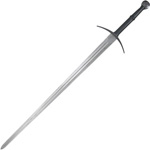
The colloquially known bastard sword is also referred to as the hand and a half sword. It is a sword with an extended grip and sometimes pommel so that it can be used with either one or two hands. Although these swords may not provide a full two-hand grip, they allow its wielders two options for its use. One is able to hold a shield or parrying dagger in their off hand, or one is able to use it as a two-handed sword for a more powerful blow.
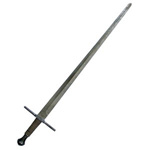
This is a generic term for any one-handed, straight single-edged sword. In the context of The Heartwood, it is similar to the bastard sword but with a shorter hilt. It is longer than a short sword, but neither long nor heavy enough to be considered a greatsword.
A traditional bow made from horn, wood and sinew laminated together. These bows are smaller and higher powered than self bows (those made only of wood). The composite hunting bow is a longbow made of multiple types of wood. It is a tall bow that allows the user a fairly long draw, generally at least to the jaw.
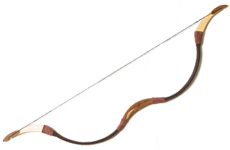
A traditional bow made from horn, wood and sinew laminated together. These bows are smaller and higher powered than self bows (those made only of wood). A recurve bow has tips that curve away from the archer when the bow is strung. This permits a shorter bow than the simple straight limb bow and is preferred by mounted archers.
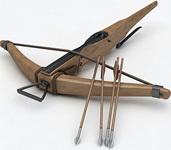
A crossbow is a bow-like assembly mounted on a stock that shoots quarrels. Because of its semi-mechanized design, crossbows have a much smaller draw length than bows. It is a projectile ranged weapon that is fairly simple to operate, and thus is easier to learn. It is also easier to maintain than a bow. For a foot soldier, it is a far more pragmatic weapon than other types of bows.
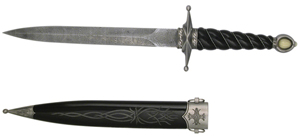
A dagger is a knifelike fighting weapon with a very sharp point designed or capable of being used as a thrusting or stabbing weapon. The dagger can have either one or both edges sharpened for cutting, al though normally both edges are sharp. It has a short blade with a sharply tapered point, a central spine and edges sharpened the full length of the blade, or nearly so. The blade can range in length from very small (an inch or so) to nearly shortsword length (up to about 24 inches). A dagger usually has a crossguard to protect the user's hand.

The lance is a pole weapon designed to be used by a mounted warrior. The primary defining difference between it and a spear is the vamplate — a small circular plate that prevents the warrior's hand from sliding up the shaft on impact. The lance is usually considered a once use per engagement weapon as it is generally too long, heavy and slow to retrieve in the midst of a melee.
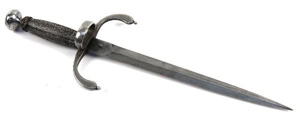
The main gauche (French: left hand) is a parrying dagger used as an off-hand weapon in conjunction with a single-handed sword. As the name implies, they were designed to parry more effectively than a simple dagger form. They typically incorporate a wider guard and often some other defensive features to better protect the hand, as well. It may also be used for attack if an opportunity arises.
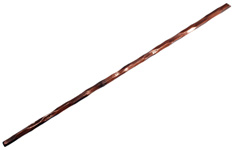
A quarterstaff is a traditional pole weapon and uses a variety of stick fighting methods. It is a shaft of hardwood, usually between six and nine feet in length and is also referred to as a short staff.
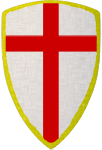
Smaller than the kite shield on which it was based, the heater shield can be used both mounted and on foot. This is the type of shield seen most common on The Heartwood, used by the Squires and Knights of Rames as well as many Jvillian soldiers.
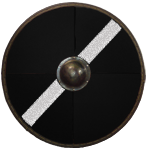
As the name implies, the round shield is circular with a diameter ranging from 18 to 36 inches. Those rare few seen on The Heartwood tend toward the smaller end of the range. Made from light wood that is not inclined to split, and often reinforced with around the rim with leather, iron, Darksteel or — as rumors say — Ironsilver. At the center of the shield is a domed boss, which protects the hand and can also catch and trap incoming sword blades, allowing the blade to be twisted from the opponent's hand. The shield is gripped from the inside of the boss; because the arm does not slip through any straps, it allows the shield to rotate much more freely. All round shields that have been seen are black with a stripe of silver.
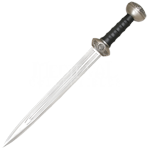
Longer than a dagger, a short sword generally ranges from 24 to 33 inches in length. It can be used for cutting and chopping maneuvers as well as for thrusting. The Heartwood shortsword is modeled after the Roman gladius; it may have a pommel, but usually lacks a crossguard.
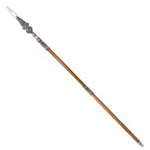
A spear is a pole weapon consisting of a shaft and a pointed head. The head can be simply the sharpened end of the shaft itself, or made of a more durable material fastened to the spear, usually steel or iron.